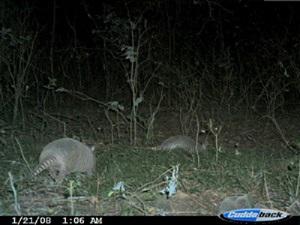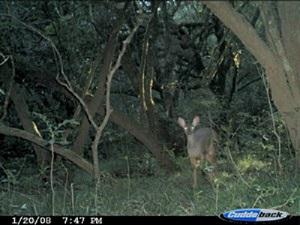María José Andrade Nunez
To determine land-use changes in Rivera, Uruguay, where the most important land-use change has been exotic tree plantations establishment. Determine mammal species richness and composition in native forest, grassland and exotic tree plantation and determine which habitat and landscape variables are the best predictors of local species richness.

Dasypus novemcinctus.
In Uruguay, exotic tree plantations increased rapidly following the implementation of the Forestry Law (N° 15,939) which provided incentives and subsidies to investors that developed exotic tree plantations on soils of low fertility. In 1987, 31,000 ha were planted primarily with Eucalyptus and Pinus spp and by 2005 the area covered by plantations was approximately 766.000 ha. This activity is becoming economically important and it is expected that by the year 2020 the area under exotic tree plantations will reach 900.000ha, 5% of the country. Plantations occur throughout the country but a hotspot of plantations is located in Rivera department.

Mazama gouazoubira.
However, in Uruguay, no studies exist about the effects of landscape structure (e.g. % and land use types, forest size, patchiness and connectivity) on the extent of mammal species utilization of natural and anthropogenic habitats. This information is necessary to identify species that are more vulnerable to human land use transformation. Under this scenario it is a priority to assess the variation of medium and large mammal species richness and composition between native forest, grassland and plantation; and determine if the differences are related to habitat quality and/or landscape structure. Thus, this will indirectly determine the effect that plantations have on mammal assemblages, and suggest potential plantation management strategies that minimize their negative effect on mammal species diversity and distribution.
A land-use changes analysis will be done in Rivera using satellite images form 1990 and 2007. Differences in the major land-use classes will be identified. In addition to this, 30 sites will be selected: 10 native forest, 10 grasslands and 10 exotic tree plantations and measures of habitat and landscape structure as well as mammal surveys will be conducted. Habitat parameters that are relevant for mammal species (e.g. plant diversity, soil cover, average height of first branches, canopy cover, temperature and humidity) will be measured. Landscape structure will be determined using satellite images. For each site, landscape structure variables (e.g. type, perimeter and area) of each land-use class as well as their proportion and spatial arrangement will be recorded at 4 scales (0.1 km, 1 km, 5 km and 10 km). Mammal species richness and composition will be determined using camera traps (direct method), track traps (indirect method) and line transects to detect individuals (direct observations) as well as tracks, faeces, bones and dens (indirect observations) of mammals.